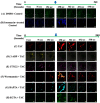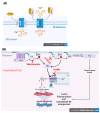An Immune-Independent Mode of Action of Tacrolimus in Promoting Human Extravillous Trophoblast Migration Involves Intracellular Calcium Release and F-Actin Cytoskeletal Reorganization
- PMID: 39596157
- PMCID: PMC11593602
- DOI: 10.3390/ijms252212090
An Immune-Independent Mode of Action of Tacrolimus in Promoting Human Extravillous Trophoblast Migration Involves Intracellular Calcium Release and F-Actin Cytoskeletal Reorganization
Abstract
We have previously reported that the calcineurin inhibitor macrolide immunosuppressant Tacrolimus (TAC, FK506) can promote the migration and invasion of the human-derived extravillous trophoblast cells conducive to preventing implantation failure in immune-complicated gestations manifesting recurrent implantation failure. Although the exact mode of action of TAC in promoting implantation has yet to be elucidated, the integral association of its binding protein FKBP12 with the inositol triphosphate receptor (IP3R) regulated intracellular calcium [Ca2+]i channels in the endoplasmic reticulum (ER), suggesting that TAC can mediate its action through ER release of [Ca2+]i. Using the immortalized human-derived first-trimester extravillous trophoblast cells HTR8/SVneo, our data indicated that TAC can increase [Ca2+]I, as measured by fluorescent live-cell imaging using Fluo-4. Concomitantly, the treatment of HTR8/SVneo with TAC resulted in a major dynamic reorganization in the actin cytoskeleton, favoring a predominant distribution of cortical F-actin networks in these trophoblasts. Notably, the findings that TAC was unable to recover [Ca2+]i in the presence of the IP3R inhibitor 2-APB indicate that this receptor may play a crucial role in the mechanism of action of TAC. Taken together, our results suggest that TAC has the potential to influence trophoblast migration through downstream [Ca2+]i-mediated intracellular events and mechanisms involved in trophoblast migration, such as F-actin redistribution. Further research into the mono-therapeutic use of TAC in promoting trophoblast growth and differentiation in clinical settings of assisted reproduction is warranted.
Keywords: F-actin cytoskeleton; FK506); FKBP12; [Ca2+]i; extravillous trophoblasts; inositol triphosphate receptor (IP3R); tacrolimus (TAC.
Conflict of interest statement
The authors declare no conflict of interest.
Figures






Similar articles
-
Low-Dose Tacrolimus Promotes the Migration and Invasion and Nitric Oxide Production in the Human-Derived First Trimester Extravillous Trophoblast Cells In Vitro.Int J Mol Sci. 2022 Jul 29;23(15):8426. doi: 10.3390/ijms23158426. Int J Mol Sci. 2022. PMID: 35955565 Free PMC article.
-
Oleic acid stimulation of motility of human extravillous trophoblast cells is mediated by stearoyl-CoA desaturase-1 activity.Mol Hum Reprod. 2017 Nov 1;23(11):755-770. doi: 10.1093/molehr/gax051. Mol Hum Reprod. 2017. PMID: 29117333
-
Ryanodine receptor calcium release channels in trophoblasts and their role in cell migration.Biochim Biophys Acta Mol Cell Res. 2022 Jan;1869(1):119139. doi: 10.1016/j.bbamcr.2021.119139. Epub 2021 Oct 6. Biochim Biophys Acta Mol Cell Res. 2022. PMID: 34624436
-
Bcl-2 and FKBP12 bind to IP3 and ryanodine receptors at overlapping sites: the complexity of protein-protein interactions for channel regulation.Biochem Soc Trans. 2015 Jun;43(3):396-404. doi: 10.1042/BST20140298. Biochem Soc Trans. 2015. PMID: 26009182 Review.
-
Coordinate control of cytoskeletal remodeling and calcium mobilization during T-cell activation.Immunol Rev. 2013 Nov;256(1):80-94. doi: 10.1111/imr.12123. Immunol Rev. 2013. PMID: 24117814 Free PMC article. Review.
Cited by
-
Tacrolimus (FK506) promotes placentation and maternal-fetal tolerance through modulating FASN-CEACAM1 pathway.Front Immunol. 2025 Feb 19;16:1522346. doi: 10.3389/fimmu.2025.1522346. eCollection 2025. Front Immunol. 2025. PMID: 40046057 Free PMC article.
-
Role of Ca2+/calmodulin and PI3K/AKT signaling pathways and active ingredients of BaoTaiYin in treatment of recurrent miscarriage.Front Mol Biosci. 2025 Mar 25;12:1573294. doi: 10.3389/fmolb.2025.1573294. eCollection 2025. Front Mol Biosci. 2025. PMID: 40201242 Free PMC article.
References
-
- Goring S.M., Levy A.R., Ghement I., Kalsekar A., Eyawo O., L’Italien G.J., Kasiske B. A network meta-analysis of the efficacy of belatacept, cyclosporine and tacrolimus for immunosuppression therapy in adult renal transplant recipients. Curr. Med. Res. Opin. 2014;30:1473–1487. doi: 10.1185/03007995.2014.898140. - DOI - PubMed
-
- Stoelinga A.E.C., Tushuizen M.E., van den Hout W.B., Girondo M., de Vries E.S., Levens A.D., Moes D.A.R., Gevers T.J.G., van der Meer S., Brouwer H.T., et al. Tacrolimus versus mycophenolate for AutoImmune hepatitis patients with incompLete response On first-line therapy (TAILOR study): A study protocol for a phase III, open-label, multicentre, randomised controlled trial. Trials. 2024;25:61. doi: 10.1186/s13063-023-07832-w. - DOI - PMC - PubMed
-
- Albaghdadi A.J.H., Kan F.W.K. Methods and Compositions for Enhancing Fertility and/or Inhibiting Pregnancy Failure and Restoring Glucose Tolerance. CA 2837359. Patent. 2011 May 31;
-
- Albaghdadi A.J.H., Hewitt M.A., Gu S.-S., Kan F.W.K. Prevention of Placental Insufficiency in the Type 2 Diabetic New-Zealand Obese Mice by Pre-Pregnancy Administration of Macrolide-Immunosuppressant Tacrolimus. Placenta. 2013;34:A83–A84. doi: 10.1016/j.placenta.2013.06.247. - DOI
MeSH terms
Substances
Grants and funding
LinkOut - more resources
Full Text Sources
Miscellaneous

